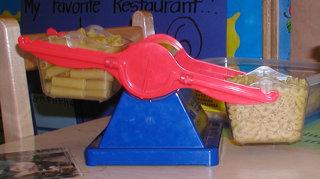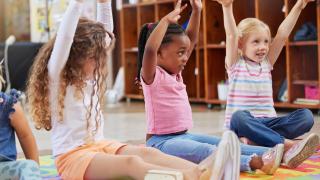
Teacher-led? Child-guided? Find the Balance in Preschool Classrooms
March 7, 2014
By Kimberly Brenneman, NIEER Assistant Research Professor
“Stick to the rules that I say.” It’s a refrain from my childhood, uttered by my next-door neighbor to make clear that while we were playing at her house, she got to choose what we did and how we did it and to change her mind any time she pleased. I’m sometimes reminded of these backyard days when I read the debates on play in early childhood classrooms. It’s almost as if some believe that a teacher who plans and leads learning experiences is telling children to “stick to the rules that she says.”
In a recent study[i], colleagues and I explored the possibility that, rather than limiting children’s free play science interactions, a planned, whole group lesson might actually enhance them. We introduced kids to the function of a balance scale during morning meeting. The lesson was interactive, and kids got to hold items to feel which was heavier, then put them on the scale to find out that the side with the heavier item always tipped down. Then we tested a few pairs of items that were hard to distinguish by felt weight. It became clear that the function of the balance scale was to help us know which of two things was heavier when our sense of felt weight could not. After the lesson, we adults placed the scale back in the science area with no comment and children were let loose to interact with centers as they wished. Meanwhile, we observed the science area and counted the number of minutes that children were present there. We had done similar counts prior to the balance scale intervention and found few children went to the science area, and no child ever touched the balance scale. After the intervention, many children went to the science area to explore the balance scale and, while doing so, found lots of other interesting objects and possibilities for play. Their knowledge of the function of the scale also increased, compared to their earlier knowledge and to that of children who hadn’t participated in the balance scale intervention.

We don’t know how much of what kids learned about the scale originated in the large group experience, and how much from interacting with the scale during choice time. What we do know is, that without an adult intervention to introduce kids to this tool, it is unlikely any of them would’ve learned about it on their own. None of them ever went near it. Using an engaging and interactive planned lesson to show and explain how a tool or material is used need not mean that play and self-guided exploration have been stifled. Instead these teaching strategies could mark the beginning of higher quality play and increased learning, guided by children, but inspired by their teacher.
About NIEER
The National Institute for Early Education Research (NIEER) at the Graduate School of Education, Rutgers University, New Brunswick, NJ, conducts and disseminates independent research and analysis to inform early childhood education policy.
Suggested Citation
[i] Nayfeld, I., Brenneman, K., & Gelman, R. (2011). Science in the classroom: Finding a balance between autonomous exploration and teacher-led instruction in preschool settings. Early Education & Development, 22(6), 970-988.
